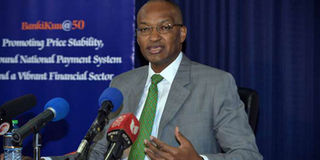Focus shifts to bonds after CBK rate slash

Central Bank of Kenya (CBK) Governor Patrick Njoroge speaks during a media briefing on the Monetary Policy Committee decisions at CBK offices on May 24, 2016. The Monetary Policy Committee lowered the Central Bank Rate (CBR) by one per cent to 10.5 per cent on account of declining inflation. PHOTO | SALATON NJAU | NATION MEDIA GROUP
What you need to know:
- CBK weekly data shows the volume of bonds traded rose by 299 per cent, with deals transacted up to 177 from 71 in the previous week.
- The Sh34 billion bond, which was issued at a coupon rate of 12.5 per cent received a premium on its weekly trades to hit 13 per cent.
Market focus turned to bonds last week after the Central Bank of Kenya (CBK) cut its rate for the first time in almost a year, driving up the value of the State paper.
The Monetary Policy Committee lowered the Central Bank Rate (CBR) by one per cent to 10.5 per cent on account of declining inflation (currently at 5.3 per cent from 6.5 per cent in March), and a stable shilling supported by the higher forex reserves equivalent to five months of import cover.
CBK weekly data shows the volume of bonds traded rose by 299 per cent, with deals transacted up to 177 from 71 in the previous week.
Investors targeted the nine year infrastructure bond issued in May this year, which does not attract taxation.
“This is attributed to active trading and sell buy-backs of IFB 1/2016/9 issued on 23 May 2016 that accounted for 68 per cent of all bonds worth Sh30 billion, traded in the week,” the CBK statistical bulletin reads.
The Sh34 billion bond, which was issued at a coupon rate of 12.5 per cent received a premium on its weekly trades to hit 13 per cent.
When a bond is issued, it pays a fixed rate of interest called a coupon rate until it matures. This rate is related to the prevailing interest rates and the perceived risk of the issuer.
If interest rates go down, and the coupon rate of new issues falls, the bond becomes more valuable because investors can earn more interest from buying the bond than a new issue allowing an investor to sell it for a premium.
Rich Management Chief Executive Aly Khan Satchu said the rate cut, plus the implied easing bias by the CBK policy team, certainly was the catalyst for the quadrupling of bond action as buyers sought a piece of the pie.
CfC Stanbic Bank Regional Economist Jibran Qureishi said investors were keen on Treasury Bills and bonds with falling returns on stocks at the Nairobi Securities Exchange.
“Treasury Bills and bonds have seen a lot of activity because there is a general market consensus that it is better to invest in those assets than on equities,” he said.





